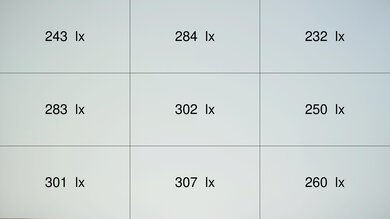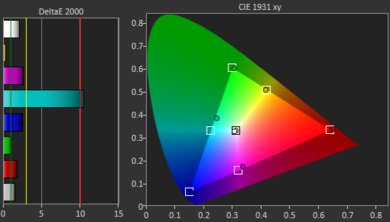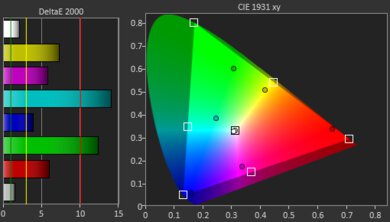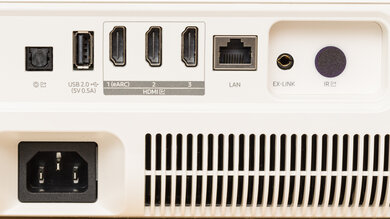The Samsung The Premiere LPU7D is a 4k HDR10+ capable Ultra Short Throw (UST) projector and replaces the Samsung The Premiere LSP7T. Just like its predecessor, the LPU7D is meant to be installed very close to the wall it's projecting to as it's capable of projecting on large surfaces from a very short distance: it projects a 90-inch image at a distance of 9.7 inches, and up to 120 inches at 16.3 inches. It comes with Samsung's Tizen OS smart interface, is compatible with the Bixby and Amazon Alexa voice assistants, and is fully cast capable. Its three HDMI 2.0 ports are each capable of outputting 4k @ 60Hz, and it has Wi-Fi 5, Bluetooth 5.2, and an Auto Game Mode for gaming. Finally, it uses a laser light source with a lamp life of at least 20000 hours, and it has a 30W 2.2ch speaker system.
Our Verdict
The Samsung Premiere 7 is mediocre for watching movies. While its contrast is alright when watched in dark rooms, its brightness isn't nearly good enough to overcome any lights. Furthermore, the projector's accuracy before calibration is poor, especially when it comes to colors, and they're hard to improve upon with calibration. It displays a wide range of colors, but it's just not bright enough to make them pop.
-
Wide color gamut
-
Poor pre-calibration accuracy
-
Its colors are hard to calibrate
-
Can't overcome any lights due to its sub-par brightness
- 6.2 Movies
Changelog
Check Price
Differences Between Sizes And Variants
We bought and tested the Samsung Premiere 7, which replaces the Samsung The Premiere LSP7T. It has a higher-end model, the Samsung The Premiere LPU9D, or The Premiere 9 for short. The 9 has enhanced features over the 7, such as a higher peak brightness rating of 3450 ISO lumens, a triple laser light source, a wider color gamut, and a more powerful 40W 2.2.2 channel speaker system. The Premiere 9 can also project at shorter distances than the 7 can, as low as 4.4 inches when projecting a 100-inch image or 9.4 inches when projecting a 130-inch image.
Our unit was manufactured in July 2024, as seen on the label.
Compared To Other Projectors
Just like the Samsung The Premiere LSP7T it replaces, the Samsung Premiere 7 is not a good value for the money. It's wildly inaccurate out-of-the-box, and its colors are hard to improve upon with calibration, requiring significant work from the calibrator. Furthermore, the projector is rather dim, and its contrast is only alright. It does have a wide color gamut, but it's just not bright enough to make colors pop. It's also a rather expensive unit, and at that price range, there are much better Ultra Short Throw options, such as the far more vibrant NexiGo Aurora Pro, Formovie THEATER, and Epson EpiqVision Ultra LS800, all of which are brighter, with better contrast, than the Samsung.
Check out our recommendations for the best short-throw projectors and the best projectors. If you'd prefer a cheaper unit, look up the best cheap projectors instead.
The Epson EpiqVision Ultra LS800 is better than the Samsung The Premiere LPU7D. The Samsung does have a slightly wider color gamut, but it doesn't matter, as it's just not bright enough to make colors pop. The Epson, however, is one of the brightest projectors we've tested, and while its contrast is only decent, it's still better than the Samsung's. The Epson is also much more accurate, and while they're both ultra-short throw projectors, the Epson can be placed even closer to the wall than the Samsung can.
The Samsung The Premiere LPU7D has slightly better contrast than the Samsung The Premiere LSP7T, but otherwise, the LSP7T is the better product overall. The LSP7T is brighter, with a wider color gamut than the LPU7D. While both projectors are inaccurate out-of-the-box, the LPU7D is even more so, and its colors are much harder to calibrate than they are on the LSP7T.
The Formovie THEATER is noticeably better than the Samsung The Premiere LPU7D. While the Samsung has okay contrast, the Formovie has one of the best contrast ratios we've seen on a projector, making it far superior as a home theater option. It's also brighter than the Samsung, making it a bit more versatile when it comes to having lights in the room. Both projectors are inaccurate out-of-the-box, but the Formovie is a bit less so, and it's far easier to calibrate than the Samsung. Finally, the Formovie has a wider color gamut.
The NexiGo Aurora Pro is far better than the Samsung The Premiere LPU7D. The NexiGo has some of the best contrast we've ever seen on a projector, and its brightness is also quite good; inversely, the Samsung's brightness is sub-par, so it can't handle any lights, and its contrast is only okay. The Samsung has a wide color gamut, but the NexiGo has an absolutely outstanding color gamut and is even capable of displaying almost the entirety of the Rec. 2020 color space, which the Samsung struggles with. Finally, while they're both inaccurate out-of-the-box and neither are easy to calibrate, the NexiGo is a tad more accurate.
Test Results
The projector is big and heavy and requires an outlet to function, so it isn't made with portability in mind. It also lacks auto keystone correction, so you'll need to adjust the screen geometry manually, and it doesn't have autofocus. It has an integrated 30W 2.2 channel speaker system, so you won't need to worry about connecting it to a soundbar if you move it.
The Samsung Premiere 7 uses a laser light source, which requires no maintenance and will last for 20,000 hours or more. This means you likely won't ever have to worry about replacing its light source. It's an Ultra Short Throw (UST) projector, capable of projecting an image on a 90-inch screen at a distance of 9.7 inches up to a 120-inch screen at a distance of 16.3 inches. The projector doesn't do true 4k as it uses pixel shifting to create a higher resolution image. This offers better quality than 1080p but doesn't look as good as native 4k.
This projector has sub-par brightness, albeit with good brightness uniformity. Still, it's noticeably dimmer than the Samsung The Premiere LSP7T and should only be used in dark rooms, as it's not bright enough to overcome any lights.
The Samsung Premiere 7's contrast is alright. Its blacks aren't deep or inky, as they're raised no matter how bright or dark the scene is. Still, it's okay enough that you won't be annoyed when using this projector in a dark room.
The projector has poor pre-calibration image accuracy. Its reds are underrepresented in all shades of gray except near-blacks, making the projector's image too cold out-of-the-box. Colors are very inaccurate, as most colors have noticeable color mapping issues. Saturated cyans look green, and yellows also lean towards green. Regarding gamma, most scenes are noticeably too dark, although bright scenes are too bright.
The Samsung Premiere 7 has full-color calibration and 20-point white balance calibration, but it's rather hard to calibrate. While it's easy to improve the unit's white balance and color temperature to near perfection, the unit's colors are stubborn and still inaccurate after one hour of calibration. Cyans are still very green, and purples lean more towards red than they previously did. Thankfully, gamma is now almost exactly on target, but overall, you'll need to put in significant work to calibrate this unit's colors.
The Samsung Premiere 7 has Samsung's popular Tizen smart OS with full casting support, so you can share your phone or laptop screen directly to the projector. The projector has a 30W 2.2 channel speaker system with a subwoofer.
Comments
Samsung The Premiere LPU7D: Main Discussion
Let us know why you want us to review the product here, or encourage others to vote for this product.
The full review has been posted here. Let us know what you think!
























